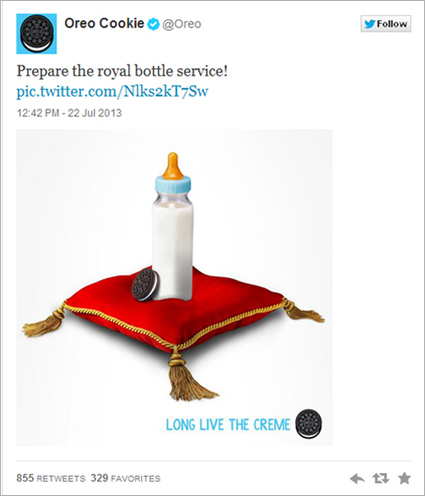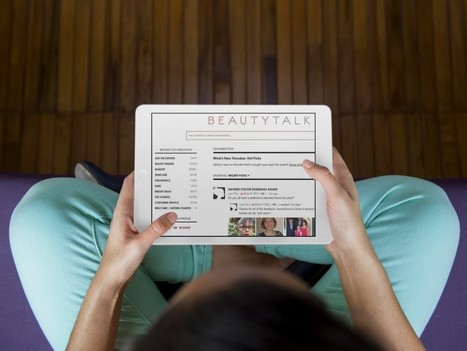 Your new post is loading...
 Your new post is loading...
On social, content is the unchallenged king. Users abhor ads in their feeds. Instead, sponsored content on Facebook has become an instant hit for brands.
In 2015, there was a marked increase in the popularity of brand videos on YouTube. In 2016, brands took social video storytelling to another level, not only on YouTube, but on Facebook and Instagram as well, and were rewarded for their efforts.
That’s according to social media analytics company Unmetric, which tracked social campaigns throughout the year as it did in 2015 to determine which ones performed best in terms of engagement.
"Videos have moved from being just reposts of 30-second TV spots to long-form storytelling, with the popular Nike Football post being nearly six minutes long," Unmetric CEO and co-founder Lux Narayan told Adweek. "This year really showed that there's an appetite and attention span for longer branded content if it's authentic and tells a story that resonates well with people, not merely as consumers but universally as humans."
Unmetric studies Twitter, Facebook and Instagram data to determine an engagement score for brand posts of zero to 1,000. The engagement score is a weighted measurement based on the idea that some metrics like shares and retweets have more value for brands than others such as likes and favorites. For YouTube, the company uses a different method for measuring the successfulness of a campaign. There is no engagement score, but likes and how quickly a video accumulates them are important factors. It also uses a combination of its own algorithms and human insights to determine overall engagement....
... One particularly large group of contributors to the mass of content uploaded to Facebook every day are brands looking to gain new customers and make a few sales. Unfortunately, it’s this group of contributors who are arguably contributing most to Facebook fatigue. Brands are all over Facebook, even if you don’t actually like any brand pages. Advertising and suggested posts mean that you’re bound to come across a brand post at some point, while ‘like and share’ competitions mean that you’re even more likely to have your news feed polluted by branded content.
That’s not necessarily a bad thing; a lot of brands do have genuinely interesting things to say and provide some entertaining stuff that deserves to be shared. However, a lot of brands have fallen into Facebook auto-pilot, relying on a banal template of posts and images formulated by set ideas of what a brand should ‘do’ on Facebook and a desperation not to offend.
You’ve undoubtedly seen the type of content I’m talking about; ‘LIKE this post if you like dogs, SHARE it if you love dogs’ from a company selling washing machines; ‘It’s Monday, tell us who you’re favourite member of ABBA is’ from a gambling company. Its content designed to get likes and shares, regardless of relevancy to the brand posting it...
Many brands jumped into the real-time marketing fray with the Royals’ latest addition to the family on Monday. This effort wasn’t as effective as what took place during the Super Bowl blackout for a reason I’ll get into in a minute.
Still, I don’t think the Mashable headline, “Brands, Try, Fail to Capitalize on Royal Baby Hype” quite captures the situation. After all, the Oreo Cookie tweet triggered more than 800 retweets and more than 300 favorites, not exactly chopped liver (no charge Nabisco for the cookie filling idea).
Piggybacking onto major news events can give brands a shot at instant relevance. Or immediate embarrassment.Last week, a German lingerie company circulated some racy but sub-par ads that attempted to capitalize on the Edward Snowden whistle-blower story. They were created quickly, though not very cleverly, and got some play on some major sites — all free media for the brand. No harm done.
This rapid-response marketing has increased greatly in the last few years, and will continue to increase, and the ads and messages will only get faster and faster.The undisputed leader on the quick-ad draw is Oreo....
Despite its current popularity, brand reputation management is not a new concept, but today it's about actively managing the references, conversations, and feedback that typically occur online....
So, what course of action should you take? Basically, having a good defense as well as attack strategy is required. Here are seven key areas you should address: - Search engine dominance - Brand monitoring - Social media PR - Reviews and recommendations - Customer service and culture - Negative-PR management- Brand advocacy...
How can we better define the quality of branded content and entertainment? Recent contest judging suggests some criteria. Branded content and entertainment should be simple: produce a content property inspired by a brand, and delight an audience with its entertainment value or usefulness. It works for brands like Red Bull and Unilever, just as it works for Netflix or ESPN. In 2013, I’ve been the jury president at the Dubai Lynx International Festival of Creativity for its inaugural Branded Content and Entertainment category, and a jury member for the annual One Show Entertainment. Regardless of where the event occurred, both juries were challenged to answer the question: what is good branded content and entertainment? Like Hollywood, with its guilds and unions establishing the criteria for how talent is paid and credited for work, we need to better define how branded content and entertainment is awarded and ultimately perceived within the industry. The following are questions we should ask to determine the work we should celebrate....
Delivering a positive user experience online through quality content and quality web assets creates a quality outcome for the brand. ...Google’s on-going quest appears to be to filter out the attempted nonsense by some marketers so that the user search experience produces valuable results. Poor search marketing and editorial practices are disenfranchised to this objective. Audiences are demanding it. As a marketer, failure to deliver valuable content will ensure that Google and your audience will tune you out or worse, turn you off. Good content delivers a relevant connection that invokes a response through humor, shock, mystery, emotion and/or just plain valuable knowledge. My favorite article on quality content was written by Brad Shore with the Content Marketing Institute. He identifies quality content as being “jargon-free, written in an appropriate voice and style, stimulates a response and is properly structured.” More importantly, he identifies the business value of quality content by emphasizing that it: - Elevates the brand Increase brand awareness - Helps generate leads and referrals Increases customer loyalty - Differentiates your business in a powerful way...
Real-time social media marketing can be incredibly powerful as it adds elements of context and relevance to your social media content and audience interactions. The challenge for many organizations is that existing processes can stand in the way of engaging and interacting with audiences in a timely manner. Process by its nature takes time, and virtually strips organizations of being able to act in real-time. Opportunity identification, legal reviews, running approvals up the ladder, creative ideation, risk assessment, production, organizing and rallying a team to create content are a few of the factors that can grind execution of the best intentions to a halt. All of these components are important, but to capitalize on real-time opportunities on social media, certain planning and preparation will need to be in place. Also, in some cases, concessions or modifications might need to be made to your organization’s regular processes. Following are a few suggestions and ideas for how you can prepare your organization to be equipped engage in real-time on social media:...
Facebook on Wednesday rolled out a new feature that lets brands target users for status updates that don't appear on their brand Pages. The intent is to let brands target a subset of customers without alienating other members of its customer base. For example, a sporting goods brand could run a post appealing to basketball fans. While the post wouldn't appear on the brand's Page, it would run in the News Feed of fans who have an affinity for the sport. Other scenarios include a telecom carrier that wanted to target possible switchers (perhaps fans who have shown an interest in a new model of phone) rather than send a more general branding message to its overall fan population. Finally, the unit can be used for A/B testing of ads. In other words, a marketer can run two or more different messages and then see which ones do the best....
|
Josh Tetrick was standing in a Dollar Tree in Oakland, California, when he asked a customer which brand of mayo was best. The woman pointed to a gleaming white jar of Kraft.But Tetrick asked, “What about the Just Mayo?”–the flagship product of his company Hampton Creek–which sat nearby. “She said, ‘No, that’s the private-label brand at the Dollar Tree,’” Tetrick recounts. In other words, Just Mayo’s craft paper label–a label that had first been X-Acto-knifed, one at a time, for its initial appearance on shelves at Whole Foods–it didn’t register as some Brooklyn-inspired, vegan artisanal good to this bargain shopper in Oakland. It looked like the generic stuff sold by a budget retailer. “That was an important learning for me,” says Tetrick. “It shows how important context is in design.” And it cemented a hunch, that Hampton Creek, with the lofty, sometimes controversial goal of bringing sustainable, transparent, healthier processed foods to the mainstream consumer, simply didn’t make sense where many low-income and middle-class consumers were shopping: Walmart and Dollar Tree....
Forrester Research predicted that 2015 will be the year that online brand communities make a comeback, and there are many reasons to celebrate the occasion.
Brands have increasingly found that investments in social media communities aren’t paying off. After spending significant time and resources building out Facebook pages, the platform has continually tweaked its Newsfeed algorithm to the detriment of brands, dropping the organic reach of their content to a mere two percent of their fans.
Rather than submit to these closed ecosystems, and the whims of ever-changing platform features, brands can regain control of their online communities by hosting them on-site. Below we’ve highlighted some of the ways these communities can drive real ROI for brands....
...showcase–those who are doing the hard work to integrate social media into some of America’s bigger companies. And then I got to thinking–there really is no list of these people anywhere.
Oh sure, there are Twitter lists here and there. Jeremiah Owyang has his list of social media new hires (and the last time he posted it was April 7). But, I really haven’t seen a good list of corporate social media leaders anywhere.
Probably with good reason. These folks are in high demand. Any such list would be pretty valuable to recruiters and agencies/companies (insert Arik evil laugh here). So, I thought, why not create one? Or, at least START to create one.
If you’re a brand strategist, you have a point of view, an agenda, and a need to influence. You’re an activist for your brand. Today, brands must be seen as experts, and we claim that title through content marketing, which means producing content that informs your buyers and keeps them apprised of news and trends. Which makes content marketers journalists too, and with that, comes responsibility...
When analyzing branding communities we hear a lot of analysis focusing on the brand. This post examines the consumer’s motivations to follow brands on different social media platforms and their expectations when they join these branding communities.
How Consumers Use Branding Communities on Social Media Platforms
Consumers use branding communities to engage with brands. Consumers use branding communities first to share their opinions about a certain brand. Since most brands now actively respond to individual comments, there is mutual engagement between the brand and the consumer. Second, consumers “like” social media platforms such as the Facebook pages of these brands because wait for it, they actually buy and use their products. This is one of the most important factors because this is part of what motivates a consumer to join a branding community....
...Brands are answering the call to create more value for customers by publishing news and content marketing. In fact, 86% of BtoC and 91% of BtoB organizations are now using content marketing tactics. As companies adopt a publisher model of content and media creation, many are beginning to rival the reach and influence of the publications in their industry.
Amex OPEN Forum and General Mills’ Tablespoon are great examples of this. What do these changes mean for Public Relations and Communications professionals? How is PR competitively positioned compared to marketing and advertising in a content centric web? Read on for answers to these questions and more.
By providing news content that traditional sources are not, brands are creating new connections with their communities and customers. While much of content marketing falls under the realm of corporate marketing, the expertise in messaging, content creation and media relations that many Public Relations professionals bring to the table can offer a competitive advantage in 3 key areas...
... Superficially, native advertising is just new content in purchased space online (see more examples). But I think there’s so much more to it than just buying advertising. Audience sharing is a critical part of the mix. The engagement and alignment between both the advertiser’s and newspaper media’s audiences is the “secret sauce” that can really deliver stunning returns for both parties. Think about it like this. Puma seeds the content onto The Guardian’s website, but it’s also reproduced on YouTube by video embed on the football club fan page, sent out to readers via a newsletter and blog and syndicated to football aggregation websites. The newspaper gains readers who wouldn’t normally visit, and all its other advertisers benefit from eyeballs and potential clicks. Similarly, the newspaper’s readers consume the content online, in print, via apps and other social sites where it has been shared. It all serves to benefit Puma with access to audiences far beyond its already engaged fans and clothing lovers....
Brands evolve. Or die. But they must also retain something of what consumers know. Or they fade. So which is more important? And how should a brand act, when?... No business these days can just sit pretty. But the extent and nature of changes confuses many. Brands evolve. Or die. But they must also retain something of what consumers know. Or they fade. So which is more important? And how should a brand act, when? I get asked about this a lot. So here are my takes on what must stay and what can go (sometimes): Keep: 1. Your good name (in every sense) – it’s the thing people know you by. Unless of course you need to re-engineer your reputation or your old name doesn’t fit what you do anymore. 2. Your purpose – the ways you intend to change the world should remain an inspiring constant for staff and customers (providing it’s inspiring to start with, of course)...
Just like people, brands come in all shapes and sizes. A brand is not a logo, colors, fancy tag line or even a fancy Super Bowl commercial. A brand is not your Facebook page, Twitter background or set of beautifully designed Pinterest boards.... ... On average it takes a minimum of 6-7 brand touches for someone to remember your brand. You better make every touch count. It’s humans who decide if they like you or not, if they tell their friends good or bad things about you. The sooner you can acknowledge the importance of becoming a human brand and the need to truly inspire and connect with your audiences, the sooner you will see results and progress as you integrate social media into the DNA of your organization. Below are 13 characteristics of the human brand. I could write 100 of these because you can’t simply define a human nor a human brand in a short list of characteristics. However, here are 13 straight forward characteristics of human brands. If you are wondering what human brands do and think this is a good place to start....
|
 Your new post is loading...
Your new post is loading...
 Your new post is loading...
Your new post is loading...































